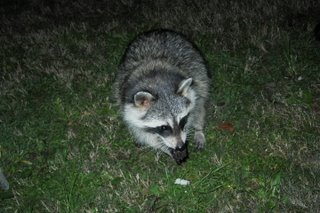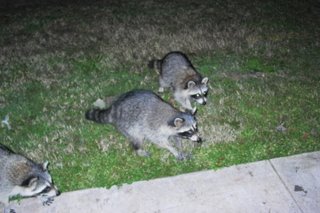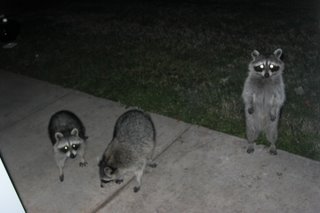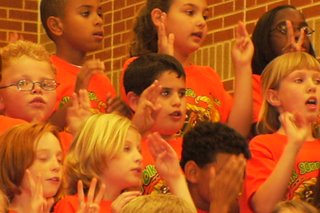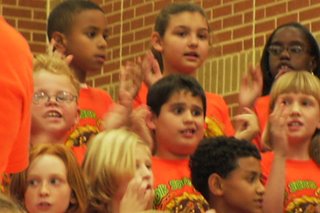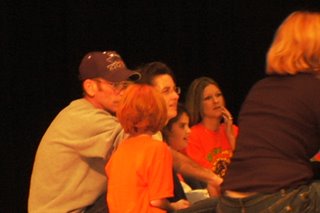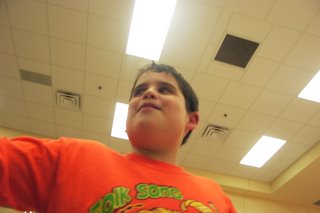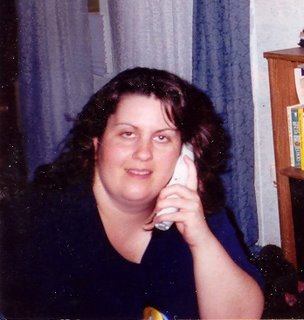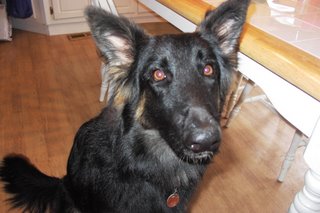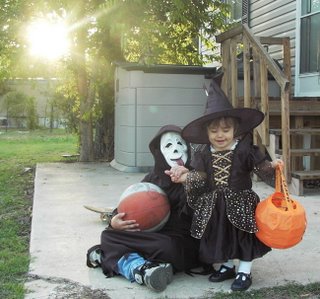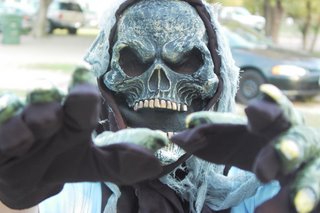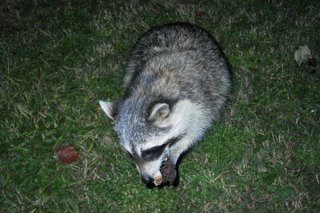
This is about my life and my family's life...living in this wonderful country called KOREA.
Tuesday, November 28, 2006
Monday, November 20, 2006
Just one word.
"Mama."
Lauren said it to me. Not gibberish.
With determination in her eye, she said my name and meant it.
"Mama!" as she hands me a book to read to her for the 100th time.
Then I melted into a puddle of goo...........
Lauren said it to me. Not gibberish.
With determination in her eye, she said my name and meant it.
"Mama!" as she hands me a book to read to her for the 100th time.
Then I melted into a puddle of goo...........
Friday, November 17, 2006
Egads!
Has it really been that long since I posted anything here. Oopsies!
Well, I've had a lot of highs and a lot of loooows this week. Yesterday, well, discovered the vinyl siding of our house on one side was blown off the day before. We had sustained winds of 40mph with gusts as high as 60mph! As my Mom said, "A little hurricane came through here." So I have an exposed part of my house which is like an open sore. Anything can get in and "infect" my house, even though I've been reassured it's all in my head. Okay...whatever. It's still an ugly sight to see though.
Matthew had his 3rd grade play last night! It was neat. He was in the choir portion of the whole thing. I wish I had brought the tripod because I was a little preoccupied with Lauren...so there are lots of movement in the pictures. Eric took still photos with the digi camera and still haven't looked at those. I'm afraid to look. LOL! I'll post what I can of those later.
Bobby should be home for Christmas vacation......Dec.18-Jan.2. He was hoping for more time off since he has over 60 days of leave that he has acquired from his tours to Iraq. We are still up in the air on when he will come back for Thanksgiving. From what he tells me, he might have to "work" the Wednesday before the holiday. If so, he will leave after his duty and drive then. Problem: Means he'll get here Thanksgiving morning. I think he wanted to sleep-in...not sleep-through...that day. Hopefully, the command there, will be nice and let him have Wednesday off so he can travel that day. What? Be nice......yeah, right!
You won't believe what I did yesterday afternoon? Really. You won't. I.....spent 2 hours on the floor....legs spread (get your head out of the gutter guys!!!!)....surrounded by........Christmas wrapping paper and ribbon! I wrapped all the gifts, minus layaway, that I had in my closet. I only have 2 people yet to get for......and, of course, they are men! I spent all of Lauren's nap time and got it done! Now I just have to keep the cats off of them (don't want their nails from their hind legs to tear up the hard work I did) and keep Lauren away (she now has hands and fingers that are nimble enough to pull at wrapping paper and tear it to shreds!)
Well, that is all for this week. Next week, well....we'll be up North with family.
NaNa...if you are reading this....the orders are in. Matthew wants lots and lots and lots of mashed potatoes and Eric wants lots and lots and lots of turkey!!! LOL! Oh, they crack me up!
Well, I've had a lot of highs and a lot of loooows this week. Yesterday, well, discovered the vinyl siding of our house on one side was blown off the day before. We had sustained winds of 40mph with gusts as high as 60mph! As my Mom said, "A little hurricane came through here." So I have an exposed part of my house which is like an open sore. Anything can get in and "infect" my house, even though I've been reassured it's all in my head. Okay...whatever. It's still an ugly sight to see though.
Matthew had his 3rd grade play last night! It was neat. He was in the choir portion of the whole thing. I wish I had brought the tripod because I was a little preoccupied with Lauren...so there are lots of movement in the pictures. Eric took still photos with the digi camera and still haven't looked at those. I'm afraid to look. LOL! I'll post what I can of those later.
Bobby should be home for Christmas vacation......Dec.18-Jan.2. He was hoping for more time off since he has over 60 days of leave that he has acquired from his tours to Iraq. We are still up in the air on when he will come back for Thanksgiving. From what he tells me, he might have to "work" the Wednesday before the holiday. If so, he will leave after his duty and drive then. Problem: Means he'll get here Thanksgiving morning. I think he wanted to sleep-in...not sleep-through...that day. Hopefully, the command there, will be nice and let him have Wednesday off so he can travel that day. What? Be nice......yeah, right!
You won't believe what I did yesterday afternoon? Really. You won't. I.....spent 2 hours on the floor....legs spread (get your head out of the gutter guys!!!!)....surrounded by........Christmas wrapping paper and ribbon! I wrapped all the gifts, minus layaway, that I had in my closet. I only have 2 people yet to get for......and, of course, they are men! I spent all of Lauren's nap time and got it done! Now I just have to keep the cats off of them (don't want their nails from their hind legs to tear up the hard work I did) and keep Lauren away (she now has hands and fingers that are nimble enough to pull at wrapping paper and tear it to shreds!)
Well, that is all for this week. Next week, well....we'll be up North with family.
NaNa...if you are reading this....the orders are in. Matthew wants lots and lots and lots of mashed potatoes and Eric wants lots and lots and lots of turkey!!! LOL! Oh, they crack me up!
Friday, November 10, 2006
Wednesday, November 08, 2006
Saturday, November 04, 2006
Thursday, November 02, 2006
Snazzy!!
| You Should Shop At Banana Republic |
 |
Wednesday, November 01, 2006
Origin of Halloween
Halloween's origins date back to the ancient Celtic festival of Samhain (pronounced sow-in).
The Celts, who lived 2,000 years ago in the area that is now Ireland, the United Kingdom, and northern France, celebrated their new year on November 1. This day marked the end of summer and the harvest and the beginning of the dark, cold winter, a time of year that was often associated with human death. Celts believed that on the night before the new year, the boundary between the worlds of the living and the dead became blurred. On the night of October 31, they celebrated Samhain, when it was believed that the ghosts of the dead returned to earth. In addition to causing trouble and damaging crops, Celts thought that the presence of the otherworldly spirits made it easier for the Druids, or Celtic priests, to make predictions about the future. For a people entirely dependent on the volatile natural world, these prophecies were an important source of comfort and direction during the long, dark winter.
To commemorate the event, Druids built huge sacred bonfires, where the people gathered to burn crops and animals as sacrifices to the Celtic deities.
During the celebration, the Celts wore costumes, typically consisting of animal heads and skins, and attempted to tell each other's fortunes. When the celebration was over, they re-lit their hearth fires, which they had extinguished earlier that evening, from the sacred bonfire to help protect them during the coming winter.
By A.D. 43, Romans had conquered the majority of Celtic territory. In the course of the four hundred years that they ruled the Celtic lands, two festivals of Roman origin were combined with the traditional Celtic celebration of Samhain.
The first was Feralia, a day in late October when the Romans traditionally commemorated the passing of the dead. The second was a day to honor Pomona, the Roman goddess of fruit and trees. The symbol of Pomona is the apple and the incorporation of this celebration into Samhain probably explains the tradition of "bobbing" for apples that is practiced today on Halloween.
By the 800s, the influence of Christianity had spread into Celtic lands. In the seventh century, Pope Boniface IV designated November 1 All Saints' Day, a time to honor saints and martyrs. It is widely believed today that the pope was attempting to replace the Celtic festival of the dead with a related, but church-sanctioned holiday. The celebration was also called All-hallows or All-hallowmas (from Middle English Alholowmesse meaning All Saints' Day) and the night before it, the night of Samhain, began to be called All-hallows Eve and, eventually, Halloween. Even later, in A.D. 1000, the church would make November 2 All Souls' Day, a day to honor the dead. It was celebrated similarly to Samhain, with big bonfires, parades, and dressing up in costumes as saints, angels, and devils. Together, the three celebrations, the eve of All Saints', All Saints', and All Souls', were called Hallowmas.
The Celts, who lived 2,000 years ago in the area that is now Ireland, the United Kingdom, and northern France, celebrated their new year on November 1. This day marked the end of summer and the harvest and the beginning of the dark, cold winter, a time of year that was often associated with human death. Celts believed that on the night before the new year, the boundary between the worlds of the living and the dead became blurred. On the night of October 31, they celebrated Samhain, when it was believed that the ghosts of the dead returned to earth. In addition to causing trouble and damaging crops, Celts thought that the presence of the otherworldly spirits made it easier for the Druids, or Celtic priests, to make predictions about the future. For a people entirely dependent on the volatile natural world, these prophecies were an important source of comfort and direction during the long, dark winter.
To commemorate the event, Druids built huge sacred bonfires, where the people gathered to burn crops and animals as sacrifices to the Celtic deities.
During the celebration, the Celts wore costumes, typically consisting of animal heads and skins, and attempted to tell each other's fortunes. When the celebration was over, they re-lit their hearth fires, which they had extinguished earlier that evening, from the sacred bonfire to help protect them during the coming winter.
By A.D. 43, Romans had conquered the majority of Celtic territory. In the course of the four hundred years that they ruled the Celtic lands, two festivals of Roman origin were combined with the traditional Celtic celebration of Samhain.
The first was Feralia, a day in late October when the Romans traditionally commemorated the passing of the dead. The second was a day to honor Pomona, the Roman goddess of fruit and trees. The symbol of Pomona is the apple and the incorporation of this celebration into Samhain probably explains the tradition of "bobbing" for apples that is practiced today on Halloween.
By the 800s, the influence of Christianity had spread into Celtic lands. In the seventh century, Pope Boniface IV designated November 1 All Saints' Day, a time to honor saints and martyrs. It is widely believed today that the pope was attempting to replace the Celtic festival of the dead with a related, but church-sanctioned holiday. The celebration was also called All-hallows or All-hallowmas (from Middle English Alholowmesse meaning All Saints' Day) and the night before it, the night of Samhain, began to be called All-hallows Eve and, eventually, Halloween. Even later, in A.D. 1000, the church would make November 2 All Souls' Day, a day to honor the dead. It was celebrated similarly to Samhain, with big bonfires, parades, and dressing up in costumes as saints, angels, and devils. Together, the three celebrations, the eve of All Saints', All Saints', and All Souls', were called Hallowmas.
History of the Jack-o-Lantern
Pumpkin carving is a popular part of modern America's Halloween celebration. Come October, pumpkins can be found everywhere in the country from doorsteps to dinner tables. Despite the widespread carving that goes on in this country every autumn, few Americans really know why or when the jack o'lantern tradition began. Or, for that matter, whether the pumpkin is a fruit or a vegetable. Read on to find out!
People have been making jack o'lanterns at Halloween for centuries. The practice originated from an Irish myth about a man nicknamed "Stingy Jack." According to the story, Stingy Jack invited the Devil to have a drink with him. True to his name, Stingy Jack didn't want to pay for his drink, so he convinced the Devil to turn himself into a coin that Jack could use to buy their drinks. Once the Devil did so, Jack decided to keep the money and put it into his pocket next to a silver cross, which prevented the Devil from changing back into his original form. Jack eventually freed the Devil, under the condition that he would not bother Jack for one year and that, should Jack die, he would not claim his soul. The next year, Jack again tricked the Devil into climbing into a tree to pick a piece of fruit. While he was up in the tree, Jack carved a sign of the cross into the tree's bark so that the Devil could not come down until the Devil promised Jack not to bother him for ten more years.
Soon after, Jack died. As the legend goes, God would not allow such an unsavory figure into heaven. The Devil, upset by the trick Jack had played on him and keeping his word not to claim his soul, would not allow Jack into hell. He sent Jack off into the dark night with only a burning coal to light his way. Jack put the coal into a carved-out turnip and has been roaming the Earth with ever since. The Irish began to refer to this ghostly figure as "Jack of the Lantern," and then, simply "Jack O'Lantern."
In Ireland and Scotland, people began to make their own versions of Jack's lanterns by carving scary faces into turnips or potatoes and placing them into windows or near doors to frighten away Stingy Jack and other wandering evil spirits. In England, large beets are used. Immigrants from these countries brought the jack o'lantern tradition with them when they came to the United States. They soon found that pumpkins, a fruit native to America, make perfect jack o'lanterns.
People have been making jack o'lanterns at Halloween for centuries. The practice originated from an Irish myth about a man nicknamed "Stingy Jack." According to the story, Stingy Jack invited the Devil to have a drink with him. True to his name, Stingy Jack didn't want to pay for his drink, so he convinced the Devil to turn himself into a coin that Jack could use to buy their drinks. Once the Devil did so, Jack decided to keep the money and put it into his pocket next to a silver cross, which prevented the Devil from changing back into his original form. Jack eventually freed the Devil, under the condition that he would not bother Jack for one year and that, should Jack die, he would not claim his soul. The next year, Jack again tricked the Devil into climbing into a tree to pick a piece of fruit. While he was up in the tree, Jack carved a sign of the cross into the tree's bark so that the Devil could not come down until the Devil promised Jack not to bother him for ten more years.
Soon after, Jack died. As the legend goes, God would not allow such an unsavory figure into heaven. The Devil, upset by the trick Jack had played on him and keeping his word not to claim his soul, would not allow Jack into hell. He sent Jack off into the dark night with only a burning coal to light his way. Jack put the coal into a carved-out turnip and has been roaming the Earth with ever since. The Irish began to refer to this ghostly figure as "Jack of the Lantern," and then, simply "Jack O'Lantern."
In Ireland and Scotland, people began to make their own versions of Jack's lanterns by carving scary faces into turnips or potatoes and placing them into windows or near doors to frighten away Stingy Jack and other wandering evil spirits. In England, large beets are used. Immigrants from these countries brought the jack o'lantern tradition with them when they came to the United States. They soon found that pumpkins, a fruit native to America, make perfect jack o'lanterns.
Subscribe to:
Posts (Atom)
